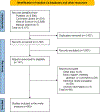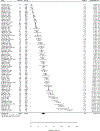Global Prevalence of Fecal Incontinence in Community-Dwelling Adults: A Systematic Review and Meta-analysis
- PMID: 37734583
- PMCID: PMC10948379
- DOI: 10.1016/j.cgh.2023.09.004
Global Prevalence of Fecal Incontinence in Community-Dwelling Adults: A Systematic Review and Meta-analysis
Abstract
Background & aims: Fecal incontinence (FI) can considerably impair quality of life. Through a systematic review and meta-analysis, we sought to determine the global prevalence and geographic distribution of FI and to characterize its relationship with sex and age.
Methods: We searched PubMed, Web of Science, and Cochrane Library databases to identify population-based surveys of the prevalence of FI.
Results: Of the 5175 articles identified, the final analysis included 80 studies; the median response rate was 66% (interquartile range [IQR], 54%-74%). Among 548,316 individuals, the pooled global prevalence of FI was 8.0% (95% confidence interval [CI], 6.8%-9.2%); by Rome criteria, it was 5.4% (95% CI, 3.1%-7.7%). FI prevalence was greater for persons aged 60 years and older (9.3%; 95% CI, 6.6%-12.0%) compared with younger persons (4.9%; 95% CI, 2.9%-6.9%) (odds ratio [OR], 1.75; 95% CI, 1.39-2.20), and it was more prevalent among women (9.1%; 95% CI, 7.6%-10.6%) than men (7.4%; 95% CI, 6.0%-8.8%]) (OR, 1.17; 95% CI, 1.06-1.28). The prevalence was highest in Australia and Oceania, followed by North America, Asia, and Europe, but prevalence could not be estimated in Africa and the Middle East. The risk of bias was low, moderate, and high for 19 (24%), 46 (57%), and 15 (19%) studies, respectively. Exclusion of studies with high risk of bias did not affect the prevalence of FI or heterogeneity. In the meta-regression, the high study heterogeneity (I2 = 99.61%) was partly explained by age.
Conclusions: Approximately 1 in 12 adults worldwide have FI. The prevalence is greater among women and older people.
Keywords: Accidental Bowel Leakage; Anal Incontinence; Bowel Incontinence; Epidemiology.
Copyright © 2024 AGA Institute. Published by Elsevier Inc. All rights reserved.
Conflict of interest statement
Conflict of interest: All authors report that they have no conflicts of interest.
Figures



References
-
- Bharucha AE, Knowles CH, Mack I, et al. Faecal incontinence. Nat Rev Dis Primers. - PubMed
-
- Bharucha AE, Dunivan G, Goode PS, et al. Epidemiology, pathophysiology, and classification of fecal incontinence: state of the science summary for the National Institute of Diabetes and Digestive and Kidney Diseases (NIDDK) workshop. Am Gastroenterol. Jan 2015;110(1):127–36. doi:10.1038/ajg.2014.396 - DOI - PMC - PubMed
Publication types
MeSH terms
Grants and funding
LinkOut - more resources
Full Text Sources
Medical

